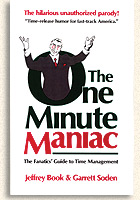|
|
||||||
| "If you've grown weary and frustrated trying to make sense of life's perplexities by reading the hyped-up, superficial advice dispensed in the ever-growing genre of best-selling pop psychology books, relief is here . . . the last self-help book you'll ever have to read." --Clarence Petersen, Chicago Tribune ". . . takes on every pop business book ever written and wins hands down . . . good for a lot of laughs and more than one reading." --Peter Key, Atlantic City Sunday Press |
 The One Minute Maniac The Fanatic's Guide to Time Management by Jeffrey Book & Garrett Soden | Published by Andrews, McMeel & Parker | 1987; 140 pages; ISBN 0-8362-1260-6 | $5.95US; Paperback HOISTING THE BUSINESS FABLE GENRE on its own petard, in The One Minute Maniac Soden (and coauthor Jeffrey Book) skewer purveyors of overly simplistic management advice by telling the tale of one Ernest Fellow. Employed as a Junior Entity at CanSys (slogan: "We're People Helping Themselves Help Others Help More People"), Ernest searches for the secret to managerial efficiency and eventually finds his guru, the One Minute Maniac. The Maniac's wisdom is dispensed in cryptic advice such as "Three Words Good, More Words Bad," and techniques such as the Minute Hype and Minute Scam, communicated to the enthusiastic Ernest by one inane executive after another. In one chapter, Ernest learns that one manager's outrageous tirade is actually a technique called a Minute Gripe. "I think I see how Minute Gripes differ run-of-the-mill reprimands," observes Ernest. "If an employee thinks his bad behavior will drive you off the deep end, then he'll toe the line." "That's the ticket!" the executive replies, "I think of it as a deep emotional commitment that my employees and I make to each other." In another scene, an old business adage is exposed for the nonsense it is: The executive folded his hands. "I suppose," he replied, a bit more composed, "that you've heard of the 20-80 rule." With sly allusions to Orwell's Animal Farm and Baum's the Wizard of Oz, the One Minute Maniac "deflates a particularly deserving target" (West Coast Review of Books). Excerpts from the One Minute Maniac were featured on the front cover of USA Today's "Pulse of the USA" section during a week-long series that decried the frantic pace of American life. The authors were keynote speakers at the 1988 American Management Association's annual convention and also appeared on the syndicated TV talk show "Sonia Live." |
|||||
marketing | books | articles | biography | contact | home
Copyright © 2006 Garrett Soden